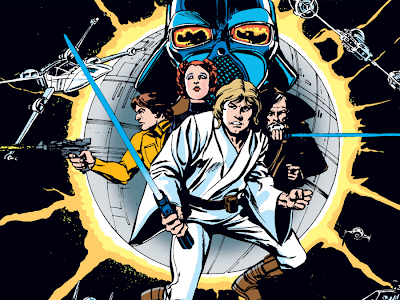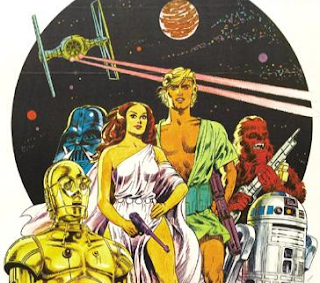 |
| Hans Hofmann Cataclysm 1945 |
Last week I indicated that Year of the Phoenix (hereinafter Phoenix) is a post-apocalypse game. The rules refer to the apocalypse at issue as the ‘cataclysm.’ According to Chapter 10 of the Adventure Guide:
North Amerika was engulfed in a cataclysmic disaster over a century ago. The exact nature of it is uncertain (letting the gamemaster tailor the facts to fit his or her campaign), but the results are all around. World population is drastically reduced, culture has been altered, and the Zoviets rule North America.The section on slang indicates that ‘Zoviet’ is the “[e]volution of the twentieth-century term, ‘Soviet.’” ‘Amerika’ is “a rebel word, to distinguish themselves from the America the Zoviet government represents.” Yes, the first paragraph of the quoted section above begins with “North Amerika” and ends with “North America.” I assume that author Martin Wixted intended a consistent spelling.
Two different versions of a possible holocaust (the Third World War) are included: one at the beginning of this chapter, and the other at the end. The first one stipulates that everyone knows what happened, while the latter assumes that portions of the world entered a 'Dark Age,' from which they are only now emerging.
In the ‘full-disclosure’ version of the cataclysm, the entry for the year 2007 begins:
Testing of a new Ion Propulsion engine by Japan American Corporation in space leads to disaster for Earth as the magnetic effects wipe out many computer systems monitoring life support, water, sewage, and power use. The polar ice caps begin to melt as Earth is ripped asunder. The Van Allen belt disrupts the Ozone Layer, admitting vast quantities of ultraviolet radiation. Earth's fault lines convulse and nuclear power plants around the globe suffer chain-reaction meltdowns.The geographic upheaval of the cataclysm affected the continents in terms of coastlines and ecology. A map of ‘North Amerika’ will have to wait for a future post, but I like to think that Wixted was inspired by the original Gamma World map when creating his setting. Otherwise, here is a portion of the world map from the back of the box:
Most of the rest of the map is covered by a text box; however, for those interested, Australia seems to be Non-Zoviet.
Among the more drastic changes, page 7 of the Adventure Guide says...
The North American continent settled, dropping many areas below sea level. These areas were eventually reclaimed when the nuclear winter increased the polar ice caps...Anyway, “The Soviets are hurt badly be the catastrophe, but gamble that the rest of the world is completely helpless.” Despite the fact that “the comparatively undamaged Asiatic Conclave surges into Russia,” the USSR makes gains in Europe and successfully invades North America. Nuclear weapons are used and “Disease begins its insidious spread as radiations sickness [sic], rabies, and cancer tear through the innocent populace.” By the time 2197 rolls around, the
The great Mojave desert has all but disappeared, thanks to the shift in the weather and the increased size of the Great Salt Lake...
No new mountain ranges sprang up as a result of the cataclysm, but most have changed in height to some extent, with several volcanoes active along the Northern West Coast.
The ‘Dark Age’ version of the cataclysm consists of flavor text on page 17 of the Adventure Guide on a graphic that is intended to represent a tattered document. Beneath the document, the bottom of the page reads, “Discovered near the Blasted Heath, and translated by Sister Emmanuel Luth.” ‘Blasted Heath,’ the slang section tells us, “Refers to any radioactive zone. Originally meant a specific radiation-soaked area in the Southwest.”
The document is titled “St. Augin's Book of Days: The Third World War” and consists of seven numbered, biblically-styled passages (20-23 and 57-59). One supposes that “The Red Death,” “the Thing,” and “Evil” are synonyms for communist forces. In passages 20-23, God commands “the ruler of the greatest nation which opposed the Thing...to go forth and end this plague.” The ruler and his “war chiefs” travel “across the great sea” whereupon the ruler “led the holy crusade across the length and breadth of the land...”
The last three passages tell us...
On the twelth year of this task, it is written that God again came unto him. In his vision the Lord spoke thusly, “Great soldier, your faith is steadfast, and your mission here is finished Return now, to your homeland, and bear all of life’s misfortunes well.” “It shall be done as you command,” the man spoke, and returned home.Sort of like The Book of Job meets Twilight: 2000.
Ill was his heart at the words of God, and his foreboding was not misguided. The Evil One had indeed fled from sight – and had struck at the ruler’s own family, rending their home asunder. The ruler fell to his knees in dismay, crying, “Lord my God, why hast thou forsaken me?”
God heard his plea, and pitied him. “It is your holy quest to destroy this Evil, to seek it out wherever it lurks and rid it from the face of the earth. Once the world is again pure, you may live in freedom. Your flock is gone, so that you may well heed my message and raise a new people who must obey my word or perish.” The ruler accepted this mission and went forth into the daylight to fulfill the Holy Word of God.
Wixted provides one last bit of ‘flavor’ regarding the cataclysm. In the slang section, there is an entry for ‘By the Day of Great Blood.’ It is defined as “An oath to swear upon, ‘By the Day of Great Blood I do swear to uphold this treaty.’ Refers to unspecified past event, having to do with the cataclysm.”










